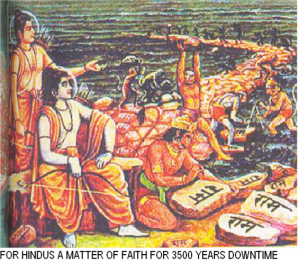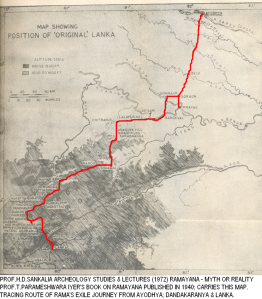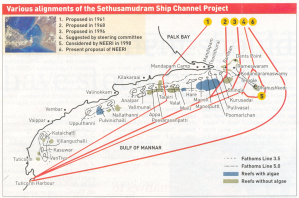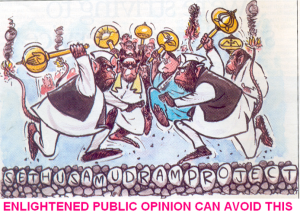1.0 Ramayan, Ramarsethu are matters of Hindu Faith and Indian Ethos for the last 3500 years. Valmiki Ramayan (1500 B.C.) in Sankrit is the original source; there are also 300 other Ramayans in different languages as it spread to the different regions of India; as also Overseas. Most Indian Historians including Romila Thapar have concluded that the events in Ramayana occurred in Central India Forests between the Ganges and the Narmada.
2.0 Prof. H.D.Sankalia, the Founding Father of Indian Archeology; in his Chanana Lectures published in 1972, has observed; that Valmiki’s narration is a truthful record of events; evidenced by the existence of Ramayan period Cities; Ayodhya, Mithila, Kanyakubja, Prayag etc.; even as on date. While agreeing with the Indian Historians, he presented Prof.T.Parameshwar Iyer’s researched & published studies; of 1940; establishing route traveled by Lord Rama after Exile from Ayodhya upto Lanka located in an Island 16 miles above Jabalpur – Madhya Pradesh. The Lectures provided the detailed rationale arising out of which the existing Indo – Sri Lankan under Sea ridge at Rameswaram; could not be justifiably identified & concluded; as the Ramarsethu of Valmiki Ramayan.
3.0 The Tamil Kambar Ramayan; in Meetchi Padalam Verse 171; describes the act of Lord Ram creating a Seaway through the Ramarsethu; with his arrow; while on the Pushpa Vimahan return journey from Sri Lanka; in order to create a safe passage for the bunched up Ships standing on either side of the Ramarsethu. The most sacred place of Hindu worship is the Ganges; which is dredged 21 Mn M³ annually for the last 150 years; to keep Kolkata Port operational.
4.0 The above said Seaway has been in usage for the last 3500 years for Ships with 4 M Draft. That what is proposed now as Sethusamudram is a deepening further to 12.5 M for a limited width of 300 M; without in any way disturbing the Ramarsethu under Sea ridge of 22 Kms.
5.0 SUPREME COURT OBSERVATIONS
Learned Legal Counsel from opponents to Project in present form/alignment; have argued that; Traditional Hindu Religious Belief’s of Ramayana, Ramarsethu are inviolable & cannot be put to judicial process of determination; the Ramarsethu should be subjected to detailed Marine Archeological Studies; Govt. of India should notify Ramarsethu as a National Monument & Heritage Structure as provided for under the Constitution; cutting through Ramarsethu would create an enormous upsurge of emotional anger identical to what happened after Babri Masjid demolition; the Ramarsethu was sacred as place of worship for the Hindus.
5.01 After hearing the arguments without going into its merits; the learned Judges of Supreme Court have suggested to the Govt. of India’s Counsel to; refer matter to G.O.I. & seek their consideration for realignment of the Canal to any other than present alternate 6. (All the opponents have accepted to agree to alternate (4); the main petitioner Subramaniam Swamy has declared in open Court his willingness to drop all proceedings if this change in alignment is carried out); as also inform the Supreme Court; on the steps taken to implement the Directions/Orders of the Madras High Court; to carry out the detailed Marine Archeological Studies.
6.0 PRUDENTIAL CAUTIOUS APPROACH OF THE SUPREME COURT
The Supreme Court of India has generally observed total restraint from expressing Opinions, Rulings, Observations, or Judgements when Traditional Religious Belief’s; have come up for Adjudication before it. The exceptions being issues which are repugnant to the Human conscience, Principles of Natural Justice, Constitutional Provisions of Fundamental Rights & Directive Principles such as abolition of Untouchability, Sati, Temple Entry ban to certain Castes, Devadasi System, etc..
6.01 In accordance with the above said; when earlier the Govt. of India made a reference on Ramayana and Rama Janmabhoomi correlated issue; the Supreme Court of India refused to adjudicate or consider it under the Judicial process of review and decision.
7.0 VARIOUS ALTERNATIVES
8.0 STEERING COMMITTEE RECOMMENDATION
The Steering Committee constituted by the Govt. of India after receiving feedback from the; Shipping, Technical & Naval Defence Authorities, recommended Alignment 4 for acceptance by the Govt.of India. The only reason that this was pushed aside & Alignment 6; chosen at further deliberations; was the representation from the residents of Rameshwaram, Temple Authorities; that the canal cutting through the Island, would put into inconvenience the 1,000 & odd pilgrims; going to Dhanuskodi to carry out Papavimochan ritual on week days; & which would move up to 10,000 on week ends/holidays & the additional advantage of reduced dredging quantum/Project costs.
9.0 CONCLUSION
The fact of the matter; is that the contemplated Sethusamudram Canal in whatever alignment is ultimately decided upon in the Supreme Court hearing of July 2008; would not in any way act against the Hindu Faith or Belief. It is for the conscience & introspection of every Hindu in India & Abroad; to decide; whether the contentious arguments that were putforth in the Public domain & before the Supreme Court of India were warranted or justified. More so since the very opposers to alternate 6; were in their earlier avatars; when in Power at the Govt. of India; had approved it; disregarding the 1996 Steering Committee Recommendations; as also putforth the Project cutting across the Ramarsethu in their Election Manifesto’s of 2001.
Political & Religious fundamentalism of any kind and from any Religion; would not be in the interest of the future of India. So therefore it is necessary Public awareness is created to the dangers of it and prevented.
M.Subramaniam, Honorary Professor & Dean Emeritus (CIDC)




Leave a comment